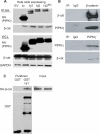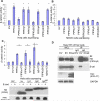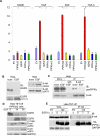PIPKIγ regulates β-catenin transcriptional activity downstream of growth factor receptor signaling
- PMID: 21303971
- PMCID: PMC3066690
- DOI: 10.1158/0008-5472.CAN-10-2480
PIPKIγ regulates β-catenin transcriptional activity downstream of growth factor receptor signaling
Abstract
Increased β-catenin transcriptional activity downstream of the Wnt/Wingless signaling pathway has been observed in many human tumors, most notably colorectal carcinomas. However, β-catenin activation is also observed in many human malignancies with no observable Wnt activity. Wnt-independent pathways that activate β-catenin remain undefined, yet have the potential to play a significant role during tumorigenesis. Here, we report that phosphotidylinositol phosphate kinase Iγ (PIPKIγ), an enzyme that generates phosphoinositide messengers in vivo, directly associates with β-catenin and increases β-catenin activity downstream of growth factor stimulation. PIPKIγ expression and kinase activity enhance β-catenin phosphorylation on residues that promote nuclear importation and transcriptional activity. Lastly, we show that β-catenin is required for PIPKIγ-dependent increased cell proliferation. These results reveal a novel mechanism in which PIPKIγ expression and catalytic activity enhance β-catenin nuclear translocation and expression of its target genes to promote tumorigenic phenotypes.
©2011 AACR.
Figures






Similar articles
-
RET/PTC1-driven neoplastic transformation and proinvasive phenotype of human thyrocytes involve Met induction and beta-catenin nuclear translocation.Neoplasia. 2009 Jan;11(1):10-21. doi: 10.1593/neo.08916. Neoplasia. 2009. PMID: 19107227 Free PMC article.
-
E-cadherin modulates Wnt-dependent transcription in colorectal cancer cells but does not alter Wnt-independent gene expression in fibroblasts.Exp Cell Res. 2006 Feb 15;312(4):457-67. doi: 10.1016/j.yexcr.2005.11.007. Exp Cell Res. 2006. PMID: 16368435
-
Involvement of splicing factor-1 in beta-catenin/T-cell factor-4-mediated gene transactivation and pre-mRNA splicing.Gastroenterology. 2007 Mar;132(3):1039-54. doi: 10.1053/j.gastro.2007.01.007. Epub 2007 Jan 5. Gastroenterology. 2007. PMID: 17383426
-
Transcription under the control of nuclear Arm/beta-catenin.Curr Biol. 2006 May 23;16(10):R378-85. doi: 10.1016/j.cub.2006.04.019. Curr Biol. 2006. PMID: 16713950 Review.
-
A possible role for the WNT-1 pathway in oral carcinogenesis.Crit Rev Oral Biol Med. 2001;12(2):152-65. doi: 10.1177/10454411010120020501. Crit Rev Oral Biol Med. 2001. PMID: 11345525 Review.
Cited by
-
Posttranslational Modifications of Smurfs: Emerging Regulation in Cancer.Front Oncol. 2021 Feb 22;10:610663. doi: 10.3389/fonc.2020.610663. eCollection 2020. Front Oncol. 2021. PMID: 33718111 Free PMC article. Review.
-
Enhancement of β-catenin activity by BIG1 plus BIG2 via Arf activation and cAMP signals.Proc Natl Acad Sci U S A. 2016 May 24;113(21):5946-51. doi: 10.1073/pnas.1601918113. Epub 2016 May 9. Proc Natl Acad Sci U S A. 2016. PMID: 27162341 Free PMC article.
-
Acute alcohol exposure impairs fracture healing and deregulates β-catenin signaling in the fracture callus.Alcohol Clin Exp Res. 2012 Dec;36(12):2095-103. doi: 10.1111/j.1530-0277.2012.01830.x. Epub 2012 Jun 12. Alcohol Clin Exp Res. 2012. PMID: 22691115 Free PMC article.
-
Pip5k1γ promotes anabolism of nucleus pulposus cells and intervertebral disc homeostasis by activating CaMKII-Ampk pathway in aged mice.Aging Cell. 2024 Sep;23(9):e14237. doi: 10.1111/acel.14237. Epub 2024 Jun 5. Aging Cell. 2024. PMID: 38840443 Free PMC article.
-
PIPKIγ promotes non-homologous end joining through LIG4 to enhance radiotherapy resistance in triple-negative breast cancer.Cell Death Dis. 2025 Jul 31;16(1):578. doi: 10.1038/s41419-025-07894-5. Cell Death Dis. 2025. PMID: 40744919 Free PMC article.
References
-
- Brembeck FH, Rosario M, Birchmeier W. Balancing cell adhesion and Wnt signaling, the key role of beta-catenin. Curr Opin Genet Dev. 2006;16(1):51–9. - PubMed
-
- Kemler R. From cadherins to catenins: cytoplasmic protein interactions and regulation of cell adhesion. Trends Genet. 1993;9(9):317–21. - PubMed
-
- Desbois-Mouthon C, Cadoret A, Blivet-Van Eggelpoel MJ, et al. Insulin and IGF-1 stimulate the beta-catenin pathway through two signalling cascades involving GSK-3beta inhibition and Ras activation. Oncogene. 2001;20(2):252–9. - PubMed
-
- Lu Z, Ghosh S, Wang Z, Hunter T. Downregulation of caveolin-1 function by EGF leads to the loss of E-cadherin, increased transcriptional activity of beta-catenin, and enhanced tumor cell invasion. Cancer Cell. 2003;4(6):499–515. - PubMed
-
- Moon RT, Bowerman B, Boutros M, Perrimon N. The promise and perils of Wnt signaling through beta-catenin. Science. 2002;296(5573):1644–6. - PubMed
Publication types
MeSH terms
Substances
Grants and funding
LinkOut - more resources
Full Text Sources

